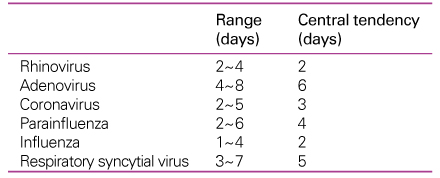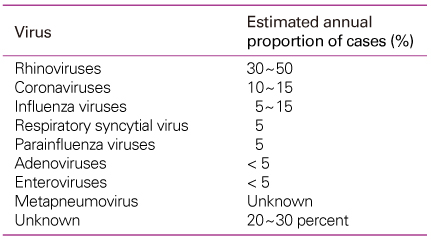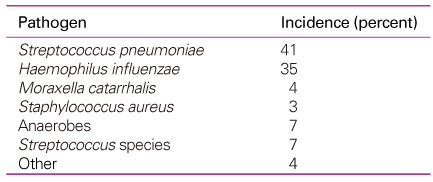 |
 |
- Search
| J Korean Med Assoc > Volume 53(1); 2010 > Article |
Abstract
Despite major advances in medicine, acute upper respiratory infections (URI) continue to be a huge burden on society in terms of human suffering. Acute rhinopharyngitis (common cold), acute sinusitis (viral and bacterial), acute pharyngotonsillitis, acute laryngitis are categorized as this common health problem. Several viruses can cause common cold, but rhinoviruses are by far the most common. Alleviation of symptoms with drugs such as nasal decongestants and acetaminophen, remains as the main way to manage common cold. Patients with acute pharyngotonsillitis should be treated with antibiotics (amoxicillin) for 10 days, but adult patients have low risk for late complications (rheumatic fever and glomerulonephritis) of S. pyogenes infection. Patients with acute viral sinusitis will recover over the course of 7~10 days without antibiotics. Amoxicillin is drug of choice for acute bacterial sinusitis in the practice guidelines. Evidence-based approach is greatly needed for appropriate care for URI patients. Effective antiviral agents and vaccines for URI pathogens should be studied, while the related researches can be challenging. Evidence-based practice for URI and patient education are good medical practice to deal with with these very common health problems.
References
1. Eikkinen T, Jarvinen A. The common cold. Lancet 2003;361:51-59.
2. Kirkpatrick GL. The common cold. Prim Care 1996;23:657-675.
3. Fendrick AM, Monto AS, Nightengale B, Sarnes M. The economic burden of non-influenza-related viral respiratory tract infection in the United States. Arch Intern Med 2003;163:487-494.
4. Tan T, Little P, Stokes T. Antibiotic prescribing for self limiting respiratory tract infections in primary care: summary of NICE guidance. BMJ 2008;337:a437.
5. Chung HJ, Lee HJ, Lee JS, Chung MH, Kim ES. Antibiotic prescription by primary care physicians for upper respiratory infections. Infect Chemother 2007;39:125-132.
6. Arroll B, Kenealy T. Are antibiotics effective for acute purulent rhinitis? Systematic review and meta-analysis of placebo controlled randomised trials BMJ 2006;333:279.
7. Eccles R. Understanding the symptoms of the common cold and influenza. Lancet Infect Dis 2005;5:718-725.
8. Arruda E, Pitkaranta A, Witek TJ Jr, Doyle CA, Hayden FG. Frequency and natural history of rhinovirus infections in adults during autumn. J Clin Microbiol 1997;35:2864-2868.
9. Taverner D, Latte J. Nasal decongestants for the common cold. Cochrane Database Syst Rev 2007;1:CD001953.
10. Turner RB. Epidemiology, pathogenesis, and treatment of the common cold. Ann Allergy Asthma Immunol 1997;78:531-539. quiz 539-540.
11. Monto AS, Sullivan KM. Acute respiratory illness in the community. Frequency of illness and the agents involved. Epidemiol Infect 1993;110:145-160.
12. Wald ER, Dashefsky B, Byers C, Guerra N, Taylor F. Frequency and severity of infections in day care. J Pediatr 1988;112:540-546.
13. Ball TM, Holberg CJ, Aldous MB, Martinez FD, Wright AL. Influence of attendance at day care on the common cold from birth through 13 years of age. Arch Pediatr Adolesc Med 2002;156:121-126.
14. Cohen S, Tyrrell DA, Smith AP. Psychological stress and susceptibility to the common cold. N Engl J Med 1991;325:606-612.
15. Nieman DC. Exercise, upper respiratory tract infection, and the immune system. Med Sci Sports Exerc 1994;26:128-139.
16. Cohen S, Doyle WJ, Alper CM, Janicki-Deverts D, Turner RB. Sleep habits and susceptibility to the common cold. Arch Intern Med 2009;169:62-67.
17. Douglas RC Jr, Couch RB, Lindgren KM. Cold doesn't affect the "common cold" in study of rhinovirus infections. JAMA 1967;199:29-30.
18. Shephard RJ, Shek PN. Cold exposure and immune function. Can J Physiol Pharmacol 1998;76:828-836.
19. Mourtzoukou EG, Falagas ME. Exposure to cold and respiratory tract infections. Int J Tuberc Lung Dis 2007;11:938-943.
20. Makinen TM, Juvonen R, Jokelainen J, Harju TH, Peitso A, Bloigu A, Silvennoinen-Kassinen S, Leinonen M, Hassi J. Cold temperature and low humidity are associated with increased occurrence of respiratory tract infections. Respir Med 2009;103:456-462.
21. Liener K, Leiacker R, Lindemann J, Rettinger G, Keck T. Nasal mucosal temperature after exposure to cold, dry air and hot, humid air. Acta Otolaryngol 2003;123:851-856.
22. Eccles R. An explanation for the seasonality of acute upper respiratory tract viral infections. Acta Otolaryngol 2002;122:183-191.
23. Papadopoulos NG, Sanderson G, Hunter J, Johnston SL. Rhinoviruses replicate effectively at lower airway temperatures. J Med Virol 1999;58:100-104.
24. Reich NG, Lessler J, Cummings DA, Brookmeyer R. Estimating incubation period distributions with coarse data. Stat Med 2009;28:2769-2784.
25. Beckham JD, Cadena A, Lin J, Piedra PA, Glezen WP, Greenberg SB, Atmar RL. Respiratory viral infections in patients with chronic, obstructive pulmonary disease. J Infect 2005;50:322-330.
26. Seemungal T, Harper-Owen R, Bhowmik A, Moric I, Sanderson G, Message S, Maccallum P, Meade TW, Jeffries DJ, Johnston SL, Wedzicha JA. Respiratory viruses, symptoms, and inflammatory markers in acute exacerbations and stable chronic obstructive pulmonary disease. Am J Respir Crit Care Med 2001;164:1618-1623.
27. Whiteman SC, Bianco A, Knight RA, Spiteri MA. Human rhinovirus selectively modulates membranous and soluble forms of its intercellular adhesion molecule-1 (ICAM-1) receptor to promote epithelial cell infectivity. J Biol Chem 2003;278:11954-11961.
28. McKinlay MA. Recent advances in the treatment of rhinovirus infections. Curr Opin Pharmacol 2001;1:477-481.
29. Barnard DL. Current status of anti-picornavirus therapies. Curr Pharm Des 2006;12:1379-1390.
30. Florea NR, Maglio D, Nicolau DP. Pleconaril, a novel antipicornaviral agent. Pharmacotherapy 2003;23:339-348.
31. Fleischer R, Laessig K. Safety and efficacy evaluation of pleconaril for treatment of the common cold. Clin Infect Dis 2003;37:1722.
32. Desmond RA, Accortt NA, Talley L, Villano SA, Soong SJ, Whitley RJ. Enteroviral meningitis: natural history and outcome of pleconaril therapy. Antimicrob Agents Chemother 2006;50:2409-2414.
33. Kim SY, Chang YJ, Cho HM, Hwang YW, Moon YS. Non-steroidal anti-inflammatory drugs for the common cold. Cochrane Database Syst Rev 2009;3:CD006362.
34. Simasek M, Blandino DA. Treatment of the common cold. Am Fam Physician 2007;75:515-520.
35. Sutter AI, Lemiengre M, Campbell H, Mackinnon HF. Antihistamines for the common cold. Cochrane Database Syst Rev 2003;1:CD001267.
36. Kuhn JJ, Hendley JO, Adams KF, Clark JW, Gwaltney JM Jr. Objective and subjective assessment. Chest 1982;82:713-718.
37. Storms W, Farrar JR. Guaifenesin in rhinitis. Curr Allergy Asthma Rep 2009;9:101-106.
38. Schroeder K, Fahey T. Over-the-counter medications for acute cough in children and adults in ambulatory settings. Cochrane Database Syst Rev 2004;4:CD001831.
39. Mossad SB. Treatment of the common cold. BMJ 1998;317:33-36.
40. Cebotarenco N, Bush PJ. Reducing antibiotics for colds and flu: a student-taught program. Health Educ Res 2008;23:146-157.
42. Jang SN, Kim NS. Understanding the culture of antibiotics prescribing of primary physicians for acute upper respiratory infection. J Korean Acad Fam Med 2004;25:901-907.
43. Kim NS, Jang SN, Jang SM. Factors influencing antibiotics prescribing of primary health physicians in acute upper respiratory tract infections. J Prev Med Public Health 2005;38:1-8.
44. Spurling GK, Del Mar CB, Dooley L, Foxlee R. Delayed antibiotics for respiratory infections. Cochrane Database Syst Rev 2007;CD004417.
45. Braun BL, Fowles JB. Characteristics and experiences of parents and adults who want antibiotics for cold symptoms. Arch Fam Med 2000;9:589-595.
46. Lee SR, Choi EY, Cheong YS, Park EW, Lim SJ, Sung HJ, Kim YJ, Ha SO. Patient's perspective of common cold and health care utilization. J Korean Acad Fam Med 2009;30:440-448.
47. Aronson MD, Weiss ST, Ben RL, Komaroff AL. Association between cigarette smoking and acute respiratory tract illness in young adults. JAMA 1982;248:181-183.
48. Farr BM, Gwaltney JM Jr, Hendley JO, Hayden FG, Naclerio RM, McBride T, Doyle WJ, Sorrentino JV, Riker DK, Proud D. A randomized controlled trial of glucocorticoid prophylaxis against experimental rhinovirus infection. J Infect Dis 1990;162:1173-1177.
49. Gustafson LM, Proud D, Hendley JO, Hayden FG, Gwaltney JM Jr. Oral prednisone therapy in experimental rhinovirus infections. J Allergy Clin Immunol 1996;97:1009-1014.
50. Singh M. Heated, humidified air for the common cold. Cochrane Database Syst Rev 2006;3:CD001728.
51. Pratter MR. Cough and the common cold: ACCP evidence-based clinical practice guidelines. Chest 2006;129:72S-74S.
52. Pratter MR. Chronic upper airway cough syndrome secondary to rhinosinus diseases (previously referred to as postnasal drip syndrome): ACCP evidence-based clinical practice guidelines. Chest 2006;129:63S-71S.
53. Crowe JE Jr. Respiratory syncytial virus vaccine development. Vaccine 2001;20:Suppl 1. S32-S32.
54. Greenberg DP, Walker RE, Lee MS, Reisinger KS, Ward JI, Yogev R, Blatter MM, Yeh SH, Karron RA, Sangli C, Eubank L, Coelingh KL, Cordova JM, August MJ, Mehta HB, Chen W, Mendelman PM. A bovine parainfluenza virus type 3 vaccine is safe and immunogenic in early infancy. J Infect Dis 2005;191:1116-1122.
55. Bartlett EJ, Cruz AM, Boonyaratanakornkit J, Esker J, Castano A, Skiadopoulos MH, Collins PL, Murphy BR, Schmidt AC. A novel human parainfluenza virus type 1 (HPIV1) with separated P and C genes is useful for generating C gene mutants for evaluation as live-attenuated virus vaccine candidates. Vaccine 2009.
56. Douglas RM, Hemila H, Chalker E, Treacy B. Vitamin C for preventing and treating the common cold. Cochrane Database Syst Rev 2007;CD000980.
57. Douglas RM, Hemila H, DSouza R, Chalker EB, Treacy B. Vitamin C for preventing and treating the common cold. Cochrane Database Syst Rev 2004;CD000980.
58. Meltzer EO, Hamilos DL, Hadley JA, Lanza DC, Marple BF, Nicklas RA, Bachert C, Baraniuk J, Baroody FM, Benninger MS, Brook I, Chowdhury BA, Druce HM, Durham S, Ferguson B, Gwaltney JM, Kaliner M, Kennedy DW, Lund V, Naclerio R, Pawankar R, Piccirillo JF, Rohane P, Simon R, Slavin RG, Togias A, Wald ER, Zinreich SJ. Rhinosinusitis: establishing definitions for clinical research and patient care. J Allergy Clin Immunol 2004;114:155-212.
59. Rosenfeld RM, Andes D, Bhattacharyya N, Cheung D, Eisenberg S, Ganiats TG, Gelzer A, Hamilos D, Haydon RC 3rd, Hudgins PA, Jones S, Krouse HJ, Lee LH, Mahoney MC, Marple BF, Mitchell CJ, Nathan R, Shiffman RN, Smith TL, Witsell DL. Clinical practice guideline: adult sinusitis. Otolaryngol Head Neck Surg 2007;137:S1-S31.
60. Gwaltney JM Jr. Acute community-acquired sinusitis. Clin Infect Dis 1996;23:1209-1223. quiz 1224-1205.
61. Anon JB, Jacobs MR, Poole MD, Ambrose PG, Benninger MS, Hadley JA, Craig WA. Antimicrobial treatment guidelines for acute bacterial rhinosinusitis. Otolaryngol Head Neck Surg 2004;130:1-45.
62. Slavin RG, Spector SL, Bernstein IL, Kaliner MA, Kennedy DW, Virant FS, Wald ER, Khan DA, Blessing-Moore J, Lang DM, Nicklas RA, Oppenheimer JJ, Portnoy JM, Schuller DE, Tilles SA, Borish L, Nathan RA, Smart BA, Vandewalker ML. The diagnosis and management of sinusitis: a practice parameter update. J Allergy Clin Immunol 2005;116:S13-S47.
63. Brook I. Acute and chronic bacterial sinusitis. Infect Dis Clin North Am 2007;21:427-448. vii.
64. Young J, De Sutter A, Merenstein D, van Essen GA, Kaiser L, Varonen H, Williamson I, Bucher HC. Antibiotics for adults with clinically diagnosed acute rhinosinusitis: a meta-analysis of individual patient data. Lancet 2008;371:908-914.
65. Ahovuo-Saloranta A, Borisenko OV, Kovanen N, Varonen H, Rautakorpi UM, Williams JW Jr, Makela M. Antibiotics for acute maxillary sinusitis. Cochrane Database Syst Rev 2008;CD000243.
66. Williams JW Jr, Aguilar C, Cornell J, Chiquette ED, Makela M, Holleman DR, Simel DL. Antibiotics for acute maxillary sinusitis. Cochrane Database Syst Rev 2003;CD000243.
67. Bisno AL, Gerber MA, Gwaltney JM Jr, Kaplan EL, Schwartz RH. Practice guidelines for the diagnosis and management of group A streptococcal pharyngitis. Infectious Diseases Society of America. Clin Infect Dis 2002;35:113-125.
68. Komaroff AL, Pass TM, Aronson MD, Ervin CT, Cretin S, Winickoff RN, Branch WT Jr. The prediction of streptococcal pharyngitis in adults. J Gen Intern Med 1986;1:1-7.
69. Bisno AL. Acute pharyngitis. N Engl J Med 2001;344:205-211.
70. Cooper RJ, Hoffman JR, Bartlett JG, Besser RE, Gonzales R, Hickner JM, Sande MA. Principles of appropriate antibiotic use for acute pharyngitis in adults: background. Ann Intern Med 2001;134:509-517.
71. Centor RM, Witherspoon JM, Dalton HP, Brody CE, Link K. The diagnosis of strep throat in adults in the emergency room. Med Decis Making 1981;1:239-246.
72. Schalen L. Acute laryngitis in adults: diagnosis, etiology, treatment. Acta Otolaryngol Suppl 1988;449:31.
73. Reveiz L, Cardona AF, Ospina EG. Antibiotics for acute laryngitis in adults. Cochrane Database Syst Rev 2007;CD004783.
74. Schalen L, Christensen P, Eliasson I, Fex S, Kamme C, Schalen C. Inefficacy of penicillin V in acute laryngitis in adults. Evaluation from results of double-blind study. Ann Otol Rhinol Laryngol 1985;94:14-17.
75. Schalen L, Eliasson I, Kamme C, Schalen C. Erythromycin in acute laryngitis in adults. Ann Otol Rhinol Laryngol 1993;102:209-214.
Table 2
Summary of incubation period estimates of viral upper respiratory infections by important pathogens

Table 4
Clinical and epidemiological findings and diagnosis of pharyngitis due to Streptococcus pyogenes (67)









